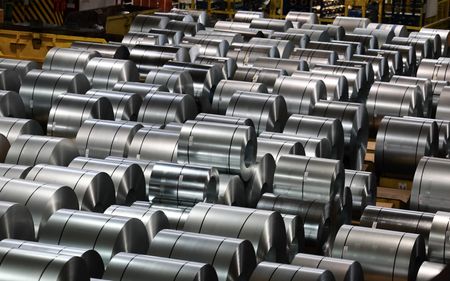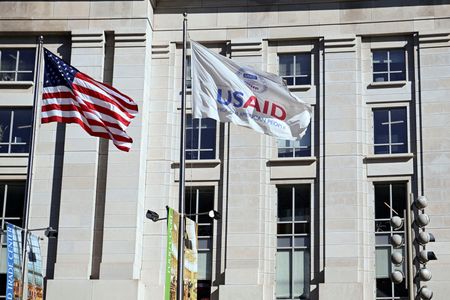By Harry Robertson and Wayne Cole
LONDON/SYDNEY (Reuters) – The dollar edged higher on Monday after U.S. President Donald Trump warned more tariffs were imminent including on steel and aluminium, although U.S. futures and European stocks shrugged off the looming levies and rose.
Speaking to reporters on Air Force One on Sunday, Trump said he would announce on Monday 25% tariffs on all steel and aluminium imports into the U.S., and reveal other reciprocal tariffs soon afterwards.
China’s retaliatory tariffs on some U.S. exports take effect on Monday, with no sign as yet of progress towards a new trade arrangement between Beijing and Washington.
Investors reacted by pushing the dollar slightly higher, with the index tracking the U.S. currency up just over 0.1% from Friday’s close, at 108.21.
It climbed 0.4% against Japan’s yen, which enjoyed its best week since November last week as investors bet on more Bank of Japan rate hikes. The euro was broadly flat at $1.0321.
The dollar rose against the currencies of commodity-exporting countries before moderating. The Canadian dollar was last around 0.3% lower.
“Much uncertainty about the nature, timing and magnitude of these tariffs looks likely to keep the dollar supported this week,” said Chris Turner, global head of markets at European bank ING.
“If these reciprocal tariffs come in this week against those countries who have a higher tariff rate than the U.S., then it may be countries like Brazil, India and Korea who are most exposed.”
U.S. stock futures initially fell on Monday but quickly recovered as investors looked ahead to another busy week of earnings. S&P 500 contracts were last up 0.53%, after the cash index fell 0.95% on Friday.
Shares had been roiled by some mixed earnings numbers last week, although overall earnings per share growth is running at 12% and above early expectations of 8%.
Europe’s continent-wide STOXX 600 index rose 0.5% after slipping 0.38% on Friday.
The shares of some European steelmakers slipped, including Luxembourg-based ArcelorMittal and Germany’s Salzgitter.
Analysts say tariffs could put upward pressure on U.S. inflation and further limit room for the Federal Reserve to ease policy, a possible outcome which has helped support the U.S. dollar since Trump’s re-election.
Markets had already scaled back expected U.S. rate cuts this year to just 36 basis points, from around 42 basis points, following a broadly upbeat payrolls report on Friday.
Fed Chair Jerome Powell is due to appear before the House of Representatives on Tuesday and Wednesday and the impact of tariffs on policy is sure to be a hot-button issue.
U.S. Treasuries were broadly steady on Monday, with yields on 10-year notes at 4.493%.
Japan’s Nikkei stock index finished flat, while Hong Kong’s Hang Seng rallied 1.84%. China’s CSI 300 climbed 0.21%.
“Markets are largely taking unfolding events in their stride,” said Derren Nathan, head of equity research at Hargreaves Lansdown.
“Stocks in China and Hong Kong were up overnight – perhaps (due to) a mixture of trade restrictions not being as bad as they might have been and hope for further Chinese stimulus.”
Worries about Chinese deflation were soothed by data showing consumer inflation accelerated to its fastest in five months in January.
Gold prices hit another record high at $2,911 an ounce, helped in part by talk that Trump might impose tariffs on the metal. [GOL/]
London aluminium traded in a tight range on Monday as investors weighed the possible metals tariffs.
Oil prices ticked up after three weeks of losses that have been partly driven by trade concerns. Brent crude was 1.4% higher at $75.69 a barrel.
(Reporting by Harry Robertson in London and Wayne Cole in Sydney; editing by Mark Heinrich)









